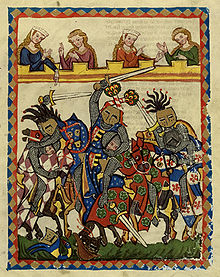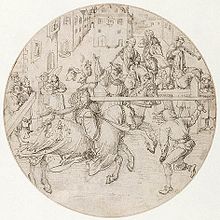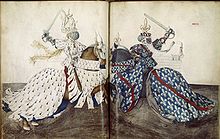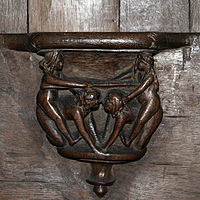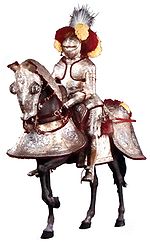- Tournament (medieval)
-
This article is about the tournaments of the Middle Ages. For tournaments in general, see tournament.
A tournament, or tourney (from Old French torneiement, tornei[1]) is the name popularly given to chivalrous competitions or mock fights of the Middle Ages and Renaissance (12th to 16th centuries). It is one of various types of hastiludes.
Contents
Definition
Of the several medieval definitions of the tournament given by Du Cange (Glossarium, s.v. "Tourneamentum"), the best is that of Roger of Hoveden, who described tournaments as "military exercises carried out, not in the spirit of hostility(nullo interveniente odio), but solely for practice and the display of prowess (pro solo exercitio, atque ostentatione virium)."
Origins
Military games were organized in Europe around 1000. Equestrian games of war are known from before the Romans: for example, chariot racing and the like were popular in Celtic Europe. Something like the medieval tourney was practiced by the Roman cavalry, from early on a critically important arm of the legions: two teams took turns chasing and fleeing each other, casting javelins in the attack and covering themselves with their shields in the retreat. These games, known as Hippica Gymnasia are known from ample archaeological and literary evidence to have been quite elaborate displays and were intended to impress their audiences. Special armor was made for them, including helms that fully covered the face against accidental injury, unlike the war helmets that left the face open for unimpeded vision and hearing. During the Early Middle Ages such cavalry games were still central to military training as is evidenced by Louis and Charles' military games at Worms in 843. At this event, recorded by Nithard, the initial chasing and fleeing was followed by a general melee of all combatants. But the tournament, properly so called, does not appear in Europe before the 11th century. Medieval people themselves devised myths about its origins. A chronicler of Tours in the late twelfth century records the death, in 1066, of an Angevin baron named Geoffroi de Preulli, who supposedly "devised (invenit) tournaments." Rüxner's sixteenth-century Thurnierbuch details the supposed tournament laws of Henry the Fowler (king of Germany, 919-936).
In fact the earliest use of the word 'tournament' comes from the peace legislation by Count Baldwin III of Hainaut for the town of Valenciennes, dated to 1114. It refers to the keepers of the peace in the town leaving it 'for the purpose of frequenting javelin sports, tournaments and such like.' The earliest reference to a recognisable tournament event is in the history of his church of St Martin of Tournai composed by Hermann of Tournai in the early 1140s, who refers to the accidental death of Henry III, Count of Leuven in his town in 1095 in a meeting between his knights and those of the castellan of Tournai. A pattern of regular tournament meetings across northern France is evident in sources for the life of Charles, Count of Flanders (1119-1127). The sources of the 1160s and 1170s portray the event in the developed form it maintained into the fourteenth century.
Shape of the tournament
Tournaments centred on the melee, a general fight where the knights were divided into two sides and came together in a charge (MFr 'estor'). Jousting, a single combat of two knights riding at each other, was a component of the tournament, but was never its main feature.
The standard form of a tournament is evident in sources as early as the 1160s and 1170s, notably the Life of William Marshal and the romances of Chrétien de Troyes. Tournaments might be held at all times of the year except the penitential season of Lent (the forty days preceding the Triduum of Easter). The general custom was to hold them on Mondays and Tuesdays, though any day but Friday and Sunday might be used. The site of the tournament was customarily announced a fortnight before it was to be held. The most famous tournament fields were in northeastern France (such as that between Ressons-sur-Matz and Gournay-sur-Aronde near Compiègne, in use between the 1160s and 1240s) which attracted hundreds of foreign knights from all over Europe for the 'lonc sejor' (the tournament season).
Knights arrived individually or in companies to stay at one or other of the two settlements designated as their lodgings. The tournament began on a field outside the principal settlement, where stands were erected for spectators. On the day of the tournament one side was formed of those 'within' the principal settlement, and another of those 'outside'.
Parties hosted by the principal magnates present were held in both settlements, and preliminary jousts (called the 'vespers' or premieres commençailles) offered knights an individual showcase for their talents. On the day of the event, the tournament was opened by a review (regars) in which both sides paraded and called out their war cries. Then followed a further opportunity for individual jousting carried out between the rencs, the two line of knights. The opportunity for jousting at this point was customarily offered to the new, young knights present.
At some time in mid morning the knights would line up for the charge (estor). At a signal, a bugle or herald's cry, the lines would ride at each other and meet with levelled lances. Those remaining on horseback would turn quickly (the action which gave the tournament its name) and single out knights to attack. There is evidence that squires were present at the lists (the staked and embanked line in front of the stands) to offer their masters up to three replacement lances. The mêlée would tend then to degenerate into running battles between parties of knights seeking to take ransoms, and would spread over several square miles between the two settlements which defined the tournament area. Most tournaments continued till both sides were exhausted, or till the light faded. A few ended earlier, if one side broke in the charge, panicked and ran for its home base looking to get behind its lists and the shelter of the armed infantry which protected them. Following the tournament the patron of the day would offer lavish banquets and entertainments. Prizes were offered to the best knight on either side, and awarded during the meals.[2]
Popularity and prohibitions
There is no doubting the massive popularity of the tournament as early as the sources permit us to glimpse it. The first English mention of tourneying is in a charter of Osbert of Arden, a Warwickshire knight of English descent, which reveals that he travelled to Northampton and London but also crossed the Channel to join in events in France. The charter dates to the late 1120s. The great tournaments of northern France attracted many hundreds of knights from Germany, England, Scotland, Occitania and Iberia. There is evidence that 3000 knights attended the tournament at Lagny-sur-Marne in November 1179 promoted by Louis VII of France in honour of his son's coronation. The state tournaments at Senlis and Compiègne held by Philip III of France in 1279 can be calculated to have been even larger events.
Aristocratic enthusiasm for the tournament meant that it had travelled outside its northern French heartland before the 1120s. The first evidence for it in England and the Rhineland is found in the 1120s. References in the Marshal biography indicate that in the 1160s tournaments were being held in central France and Great Britain. The contemporary works of Bertran de Born talk of a tourneying world which also embraced northern Iberia, Scotland and the Empire. The chronicle of Lauterberg indicates that by 1175 the enthusiasm had reached the borders of Poland.
Despite this huge interest and wide distribution, royal and ecclesiastical authority was deployed to prohibit the event. In 1130 Pope Innocent II at a church council at Clermont denounced the tournament and forbade Christian burial for those killed in them. The usual ecclesiastical justification for prohibiting them was that it distracted the aristocracy from more acceptable warfare in defence of Christianity. However, the reason for the ban imposed on them in England by Henry II had to have lain in its persistent threat to public order. Knights going to tournaments were accused of theft and violence against the unarmed. Henry II was keen to re-establish public order in England after the disruption of the reign of King Stephen (1135–1154). He did not prohibit tournaments in his continental domains, and indeed three of his sons were avid pursuers of the sport.
Tournaments were allowed in England once again after 1192, when Richard I identified six sites where they would be permitted and gave a scale of fees by which patrons could pay for a license. But both King John and his son, Henry III, introduced fitful and capricious prohibitions which much annoyed the aristocracy and eroded the popularity of the events. In France Louis IX prohibited tourneying within his domains in 1260, and his successors for the most part maintained the ban.
Bohorts, tirocinia and urban festivities
There was a family of events which resembled the tournament in their day, and which are often confused with it. The most common was the bohort (buhurdicium). This was a play tournament, which might be held informally on a variety of occasions. There is a record of one being held regularly by the youth of the city of London in the life of Thomas Becket by William fitz Stephen (composed 1171). Bohorts might be held between travelling knights, or between parties of squires, or within an encamped army. They might also form part of court festivities. Their main feature was the limited use of arms and armour and emphasis on horsemanship.
The tirocinium is first mentioned by Otto of Freising, referring back to an event at Würzburg in 1127. That and later references indicate that it was a tournament held exclusively for newly-knighted youths (tirones). The new knight was often an easy victim for older and more experienced colleagues. The tirocinium allowed them to gain experience with less danger. Tirocinia were often held following the knighting of royal and princely youths, who were usually knighted in company with dozens or scores of other aspirants.
A further addition to the family of related events was the urban tournament, designed for the youths and young men of wealthy patrician families. These were facsimiles of the aristocratic event rather than simple bohorts. The most famous of them were the tournaments held in the market streets of the great Flemish cities, notably at the religious feast of the Epinette, which is mentioned at Lille as early as 1283. They were not exclusively urban, and attracted neighbouring country knights, but their location and patronage distinguished them from the parallel aristocratic events. This form of mêlée tournament survived the longest.
Jousting and the tournament
As has been said jousting formed part of the tournament event from as early a time as it can be observed. It was an evening prelude to the big day, and was also a preliminary to the grand charge on the day itself. In the 12th century jousting was occasionally banned in tournaments. The reasons given are that it distracted knights from the main event, and allowed a form of cheating. Count Philip of Flanders made a practice in the 1160s of turning up armed with his retinue to the preliminary jousts, and then declining to join the mêlée until the knights were exhausted and ransoms could be swept up.
But jousting had its own devoted constituency by the early 13th century, and in the 1220s it began to have its own exclusive events outside the tournament. The biographer of William Marshal observed c.1224 that in his day noblemen were more interested in jousting than tourneying. In 1223 we have the first mention of an exclusively jousting event, the 'Round Table' held in Cyprus by John d'Ibelin, lord of Beirut. Round Tables were a 13th-century enthusiasm and can be reconstructed to have been an elimination jousting event. They were held for knights and squires alike. Other forms of jousting also arose during the century, and by the 14th century the joust was poised to take over the vacancy in aristocratic amusement caused by the decline of the tournament.
Equipment
 Assorted maces
Assorted maces
It is a vexed issue as to what extent specialized arms and armour were used in mêlée tournaments. A further question that might be raised is to what extent the military equipment of knights and their horses in the 12th and 13th centuries was devised to meet the perils and demands of tournaments, rather than warfare. It is however clear from the sources that the weapons used in tournaments were initially the same as those used in war. It is not by any means certain that swords were blunted for most of the history of the tournament. This must have changed by the mid 13th century, at least in jousting encounters. There is a passing reference to a special spear for use in jousting in the Prose Lancelot (c.1220). In the 1252 jousting at Walden, the lances used had 'sokets', curved ring-like punches instead of points. The Statute of Arms of Edward I of England of 1292 says that blunted knives and swords should be used in tournaments, which rather hints that their use had not been general until then.
Tournaments as an art form
By using costumes, drama and symbolism, tournaments became a form of art, which raised the expenses for these events considerably. Edward III of England regularly held tournaments, during which people often dressed up, sometimes as the Knights of the Round Table[3]. In 1331 the participants of one tournament were all wearing green cloaks decorated with golden arrows. In the same year one was held at Cheapside, in which the king and other participants dressed as Tartars and led the ladies, who were in the colours of Saint George, in a procession at the start of the event[4]. His grandson, Richard II, would first distribute livery with his badge of the White Hart at a tournament at Smithfield[5].
In 1511, at the court of Henry VIII of England, a tournament was held in honour of Catherine of Aragon. Charles Brandon came out of a tower which was moved onto the battlefield, dressed like a pilgrim. He only took off his pilgrim's clothes after the queen had given him permission to participate[6].
Later days
The decline of the true tournament was not a straightforward process, although the word continued to be used for jousts until the sixteenth century. Tourneying continued to be regarded as the best test of a warrior in 14th-century society, an idea reinforced by the prominent place that tourneying occupied in popular Arthurian romance literature. The tournament had a resurgence of popularity in England in the reign of the martial and crusading king, Edward I (1272–1307) and under his grandson, Edward III (1327–1377), yet nonetheless the tournament died out in the latter's reign. Edward III encouraged the move towards pageantry and a predominance of jousting in his sponsored events. In the last true tournament held in England in 1342 at Dunstable, the mêlée was postponed so long by jousting that the sun was sinking by the time the lines charged. The tournament survived little longer in France or Burgundy. The last known to be held was at Bruges in 1379. That same year the citizens of Ghent rioted when the count of Flanders announced a tournament to be held at their city. The cause of their discontent was the associated expense for them.
Primary sources
There are a few surviving tournament books describing the style, horsemanship and rules of the tournaments of the 15th and 16th centuries,[7] as well as accounts of tournaments dating back to the 13th century.
- L'Histoire Guillaume le Maréschal (ed. P. Meyer, Paris, 1901), ca. 1219
- Sarrazin, Le Roman du Hem, poetic account of a tournament of 1275.
- Ulrich von Liechtenstein, Frauendienst, 13th century, ed. R. Bechstein (Leipzig, 1888).
- Le Tournoi de Chauvency, 1285 (ed. M. Delbouille, Liege, 1932).
- The Book of Chivalry and Questions Concerning the Joust, Tournaments and War by Geoffroi de Charny, 14th century[8]
- Chronicles of Jean Froissart, 14th century
- Livro da ensinanca de bem cavalgar (1438)
- Traictié de la forme et devise d'ung tournoy by René d'Anjou (ca. 1460)
- Pero Rodríguez de Lena, El passo honroso de Suero de Quiñones, 15th century (ed. Amancio Labandeira, Madrid: Fundación Universitaria España, 1977).
- Alfonso de Cartagena, Chivalric Vision, ca. 1444[9]
- La form quon tenoit des tournoys et assemblees au temps du uterpendragon et du roy artus, 15th century[10]
- Díaz de Gámez, Gutierre. El victorial: cronica de don Pero Niño, 15th century (Madrid, 1989).
- Pas de Saumur, kept in the Russian National Library, St. Petersburg[11]
- manuals produced at the court of Maximilian I: Freydahl, Die Ehrenpforte
- Turnierbuch of Duke William IV of Bavaria (1541)
- Rüxner Turnierbuch (1530, 1532)
- tournament book of Duke Heinrich II of Brunswick-Lüneburg, State Library, Berlin
- Challenges and Combats Afoot, Dresden Library
- Tournament book, Metropolitan Museum of Art, before 1597[12]
- The Great Tournament Roll of Westminster, 16th century[13]
- Chacón, Hernán. Tractado de la cauallería de la gineta (1551)[14]
Notes
- ^ Enéas, c. 1150, ultimately from Latin tornare "to turn" so named owing to the rapid turning of the horses (Skeat[citation needed]); Medieval Latin torneamentum is back-formed from Old French (OED), e.g. Reims Synod, Canon 4 (1157), and Lateran Council, Canon 20 (1179).
- ^ For the reconstruction see Crouch (2005)
- ^ Mortimer, Ian (2008). The Perfect King The Life of Edward III, Father of the English Nation. Vintage. pp. 88–89.
- ^ Mortimer, Ian (2008). p. 93.
- ^ Gillespie, James L. (1997). The Age of Richard II. p. 132.
- ^ Ives, Eric (2004). The Life and Death of Anne Boleyn. Blackwell Publishing Ltd.. p. 10.
- ^ Select Bibliography on Medieval Tournaments, Jousts and Formal Deeds of Arms Steve Muhlberger, Nipissing University
- ^ (Charny, Geoffroi de.) Kaeuper, Richard W. and Elspeth Kennedy, The Book of Chivalry of Geoffroi de Charny: Text, context and translation (Philadelphia: University of Pennsylvania Press, 1996).
- ^ Fallows, Noel. The Chivalric Vision of Alfonso de Cartagena: Study and Edition of the “Doctrinal de los caualleros. Newark, Delaware: Juan de la Cuesta, 1995.
- ^ Sandoz, Edouard. "Tourneys in the Arthurian Tradition," Speculum 19 (1944): 389-420.
- ^ Das Turnierbuch für Rene D'Anjou (Pas de Saumur) Folio Edition, 2 vols. (limited to 580 copies), Commentaries by N. Elagina, J. Malinin, T. Voronova, D. Zypkin, Akademische Druck-u Verlagsanstalt, Graz, Austria ISBN 3-201-01674-8 [1]
- ^ Bashford Dean, An Early Tournament Book, The Metropolitan Museum of Art Bulletin (1922)
- ^ Anglo, Sydney, ed. The Great Tournament Roll of Westminster: A collotype reproduction of the manuscript. Oxford: Clarendon Press, 1968]
- ^ Introduction, Text and Notes, Bibliography, Lexicographical Index., ed. Noel Fallows. Exeter Hispanic Texts 55. Exeter: University of Exeter Press, 1999.
References
- D. Crouch, Tournament (London, 2005)
- J.R.V. Barker, The Tournament in England,1100-1400 (Woodbridge, 1986) ISBN 0-85115-942-7
- R. Barber and J.R.V. Barker, Tournaments: Jousts, Chivalry and Pageants in the Middle Ages (Woodbridge, 1989)
- J.Bumke, Höfische Kultur: Literatur und Gesellschaft im hohen Mittelalter (Munich, 1986) English Translation by Thomas Dunlap: Courtly Culture: Literature and Society in the High Middle Ages, New York: overlook Duckworth, 2000, ISBN 0-7156-3273-6
- M. Parisse, 'Le tournoi en France, des origines à la fin du xiiie siècle, in, Das ritterliche Turnier in Mittelalter: Beitrage zu einer vergleichenden Formentund verhallengeschichte des Rittertum, ed. J. Fleckenstein (Göttingen, 1985)
- E. van den Neste, Tournois, joutes, pas d'armes dans les villes de Flandre à la fin du moyen âge, 1300-1486 (Paris, 1996)
- L. Carolus-Barré, 'Les grand tournois de Compiègne et de Senlis en l'honneur de Charles, prince de Salerne (mai 1279)', Bullétin de la société nationale des antiquaires de France (1978/79)
- J. Vale, Edward III and Chivalry: Chivalric Society and its Context, 1270-1350 (Woodbridge, 1983).
- S. Muhlberger, Jousts and Tournaments: Charny and Chivalric Sport in the Fourteenth Century (Union City, Calif.:The Chivalry Bookshelf, 2003)
- S. Muhlberger, Deeds of Arms: Formal Combats in the Late Fourteenth Century (Highland Village, TX: The Chivalry Bookshelf, 2005)
- S. Nadot, Rompez les lances ! Chevaliers et tournois au Moyen Age, Paris, editions Autrement, 2010. (Couch your lances ! Knights and tournaments in the Middle Ages)
External links
- Academy of European Medieval Martial Arts (AEMMA), Toronto, Canada. The structure of the pas d'armes at AEMMA focuses on "combats on foot" only and encompasses numerous attributes of a late 14th and early 15th centuries balanced to satisfy the expectations of the spectators in a 21st century context by allowing them to witness extraordinary unscripted single armoured combats, while providing opportunities for the combatants to demonstrate their prowess and technique through the challenges presented in the bouts by the appellants and all the while, maintaining a strong foothold in its historical counterpart.
- What Was At Stake in Formal Deeds of Arms of the 14th Century? "Thus the formal deed of arms had an individual aspect and a collective one, and in both aspects something very real was at stake. The individual was there to be tested. Every man entered the contest intending not just to look good, but to survive, and to come away from the field worthy of greater respect. Some inevitably gained more than others. For the group, the formal deed was not so much a test but an act of definition. It was, at least in the eyes of its participants, proof that they were all armed gentlemen and that armed gentlemen deserved the lofty place in society that they in fact enjoyed. The group itself was reaffirmed in a way that was essential to its self-image. "
- The Tournament at St. Inglevert "Three French knights hold a tournament at Saint Inglevert, near Calais, and defend the lists for thirty days against all comers."
- A Collection of Accounts of Formal Deeds of Arms of the Fourteenth Century "Modern people often make a big distinction between 'tournaments' and 'real war,' but the distinction was much more fluid in the fourteenth century."
See also
Categories:- Medieval culture
- Combat sports
- Dueling
- Horse history and evolution
- Warhorses
- Medieval reenactment
- Historical European martial arts
- European court festivities
Wikimedia Foundation. 2010.


